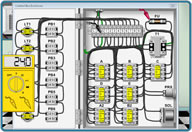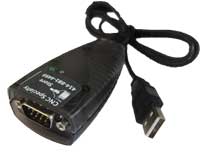Rotary table selection, interfacing, and installation considerations for machine toolsWhen selecting a rotary table or indexer for a machine tool, the most common factors considered include the type of application, machine tool type, requirements, and relative price. One of the most important considerations often initially overlooked is: HOW WILL THE ROTARY TABLE BE INTERFACED?!! When they are installed, most indexers have one M-code hooked up to actuate a series of moves in the indexer program. As a result, every time the program is stopped prior to completion, an operator must go back to the pendant or indexer control box and manually reset the program. If the operator is not aware of the situation, you can imagine the devastating results: CRASH! Given the potential for disaster, you may ask yourself why someone would purchase interface with only one M-code? The answer is simple. The customers are unfamiliar with the risks and may rely upon the service engineers to make installation decisions. The service engineers are motivated to complete the installation in the most time and cost efficient manner. It may not take the time to analyze what alternatives might be most appropriate for a customer. All too often, the customer becomes aware of the alternatives only after the fact and they begin to question whether there was anything that could have been done to prevent it. Do not let this happen to you. Be proactive, speak to your vendor or installation company and make them aware of your expectations before you purchase the rotary table! Ask questions and get quotes, keeping in mind that some of the less sophisticated indexers may not have the option of using multiple M-codes to call up positions. Also, make sure your machine tool has extra M-codes available. |
|
How do you justify a more costly indexer interface?
|
|
What will be needed to install a rotary table in a safe and efficient way?
|
|
Different types of Rotary indexer interfaces
|
Setup options to consider after installation
If you are installing an indexer, you will likely have an interference of some kind. In which you will want to prevent movement of tools into an area where you could accidentally drill into the rotary table. To prevent these types of accidents, most CNC controls have an inhibited area or window that you can set.
Another setup option to consider relates to the position of the indexer. Many times the indexer may hang over the edge of the table. In this case, you may have to set the soft over travels limits on the machine tool. Make sure you run each axis as far as possible in both the positive and negative direction to check for any interference.
Finally, when considering setup alternatives consider the tool changer position to ensure that you create a safe zone for a tool change. If you neglect to consider this, serious damage to both the machine and operator can result. A macro program, soft over travels parameters, or inhibit area can all be used to determine a safe tool change position.
Purchasing considerations for a new rotary table.
When purchasing a rotary table, remember that rotary indexers require either pneumatics or hydraulics to clamp up a brake. Consider whether you will be drilling or boring away from the center line of the indexer.
Another consideration is whether you are adding hydraulic clamping or providing part present confirmation signal to the fixture. Sometimes running lines through the Rotary tables will require a rotary union and may be more difficult to integrate depending on the model.
An additional consideration is how the rotary table cables are going to be run through the machine tool. Some machines will be very difficult, if not impossible, to integrate. Some horizontal and vertical machining centers with pallet changers can have the most complications. Potential complications include: being able to index the pallet changer more then 360 degrees by jogging or performing a recovery if stopped in middle of operation. Proper routing of cables can also cause problems, especially if there is not a hole in the center of the table to run the cables through. All the items discussed above should be evaluated when selecting an indexer. Even before giving the purchase order to your salesman, I would advise you to speak directly to the integrator who will be installing the rotary table.
M-code interfacing for your rotary table indexer
I will discuss interfacing and provide examples of interfaces at a later date.
Single M-code
Multiple M-codes by used of channels and BCD
Calling up degree increments through BCD





